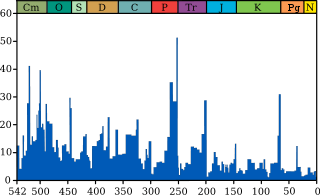Triassic–Jurassic extinction event
The Triassic–Jurassic extinction event marks the boundary between the Triassic and Jurassic periods, 201.3 million years ago,[1] and is one of the major extinction events of the Phanerozoic eon, profoundly affecting life on land and in the oceans. In the seas, a whole class (conodonts)[2] and 34% of marine genera disappeared.[3] On land, all archosaurs other than crocodylomorphs (Sphenosuchia and Crocodyliformes) and Avemetatarsalia (pterosaurs and dinosaurs), some remaining therapsids, and many of the large amphibians became extinct.
Effects

At least half of the species now known to have been living on Earth at that time became extinct. This event vacated terrestrial ecological niches, allowing the dinosaurs to assume the dominant roles in the Jurassic period. This event happened in less than 10,000 years and occurred just before Pangaea started to break apart. In the area of Tübingen (Germany), a Triassic-Jurassic bonebed can be found, which is characteristic for this boundary.[4]
Statistical analysis of marine losses at this time suggests that the decrease in diversity was caused more by a decrease in speciation than by an increase in extinctions.[5]
Current theories
Several explanations for this event have been suggested, but all have unanswered challenges:
- Gradual climate change, sea-level fluctuations or a pulse of oceanic acidification[6] during the late Triassic reached a tipping point. However, this does not explain the suddenness of the extinctions in the marine realm.
- Asteroid impact, but so far no impact crater of sufficient size has been dated to coincide with the Triassic–Jurassic boundary.
- The unconfirmed Wilkes Land crater is of sufficient size and falls within the correct age range at 100 million to 500 million years old and 2.5x the size of the Chicxulub crater.
- The eroded Rochechouart crater in France has most recently been dated to 201 ±2 million years ago,[7] but at 25 km across (possibly up to 50 km across originally), appears to be too small.[8] The impact responsible for the annular Manicouagan Reservoir occurred about 12 million years before the extinction event - the Rochechouart crater is now thought to have been caused by part of the same fragmented impactor.
- Massive volcanic eruptions, specifically the flood basalts of the Central Atlantic Magmatic Province (CAMP), would release carbon dioxide or sulfur dioxide and aerosols, which would cause either intense global warming (from the former) or cooling (from the latter).[9][10] The record of CAMP degassing shows several distinct pulses of carbon dioxide immediately following each major pulse of magmatism, at least two of which amount to a doubling of atmospheric CO2.[11]
- The isotopic composition of fossil soils of end Triassic and Early Jurassic has been tied to a large negative carbon isotope excursion (Whiteside et al. 2010). Carbon isotopes of lipids (n-alkanes) derived from leaf wax and lignin, and total organic carbon from two sections of lake sediments interbedded with the CAMP in eastern North America have shown carbon isotope excursions similar to those found in the mostly marine St. Audrie’s Bay section, Somerset, England; the correlation suggests that the end-Triassic extinction event began at the same time in marine and terrestrial environments, slightly before the oldest basalts in eastern North America but simultaneous with the eruption of the oldest flows in Morocco (Also suggested by Deenen et al., 2010), with both a critical CO2 greenhouse and a marine biocalcification crisis.
- Contemporaneous CAMP eruptions, mass extinction, and the carbon isotopic excursions are shown in the same places, making the case for a volcanic cause of a mass extinction. The catastrophic dissociation of gas hydrates (suggested as one possible cause of the largest mass extinction of all time, the so-called "Great Dying" at the end of the Permian Period) may have exacerbated greenhouse conditions.
References
- ↑ Some sources (Whiteside et al 2010) give a date 201.4 Ma.
- ↑ The extinction of conodonts —in terms of discrete elements— at the Triassic-Jurassic boundary
- ↑ Graham Ryder; David E. Fastovsky; Stefan Gartner (1996). The Cretaceous-Tertiary Event and Other Catastrophes in Earth History. Geological Society of America. p. 19. ISBN 9780813723075.
- ↑ Johannes Baier: Der Geologische Lehrpfad am Kirnberg (Keuper; SW-Deutschland) Archived 2011-10-02 at the Wayback Machine.. - Jber. Mitt. oberrhein. geol. Ver, N. F. 93, 9-26, 2011.
- ↑ Bambach, R.K.; Knoll, A.H.; Wang, S.C. (December 2004). "Origination, extinction, and mass depletions of marine diversity". Paleobiology. 30 (4): 522–542. doi:10.1666/0094-8373(2004)030<0522:OEAMDO>2.0.CO;2. ISSN 0094-8373.
- ↑ T.M. Quan, B. van de Schootbrugge, M.P. Field, "Nitrogen isotope and trace metal analyses from the Mingolsheim core (Germany): Evidence for redox variations across the Triassic-Jurassic boundary", Global Biogeochemical Cycles, 22 2008: "a series of events resulting in a long period of stratification, deep-water hypoxia, and denitrification in this region of the Tethys Ocean basin"; M. Hautmann, M.J. Benton, A. Toma, "Catastrophic ocean acidification at the Triassic-Jurassic boundary", Neues Jahrbuch für Geologie und Paläontologie 249.1, July 2008:119-127.
- ↑ Schmieder, M.; Buchner, E.; Schwarz, W. H.; Trieloff, M.; Lambert, P. (2010-10-05). "A Rhaetian 40Ar/39Ar age for the Rochechouart impact structure (France) and implications for the latest Triassic sedimentary record". Meteoritics & Planetary Science. 45 (8): 1225–1242. Bibcode:2010M&PS...45.1225S. doi:10.1111/j.1945-5100.2010.01070.x.
- ↑ Smith, Roff (2011-11-16). "Dark days of the Triassic: Lost world". Nature. 479 (7373): 287–289. Bibcode:2011Natur.479..287S. doi:10.1038/479287a. PMID 22094671. Retrieved 2011-11-18.
- ↑ Tanner, L. H.; J. F. Hubert; et al. (7 June 2001). "Stability of atmospheric CO2 levels across the Triassic/Jurassic boundary". Nature. 411 (6838): 675–677. doi:10.1038/35079548. PMID 11395765.
- ↑ Blackburn, Terrence J.; Olsen, Paul E.; Bowring, Samuel A.; McLean, Noah M.; Kent, Dennis V; Puffer, John; McHone, Greg; Rasbury, Troy; Et-Touhami7, Mohammed (2013). "Zircon U-Pb Geochronology Links the End-Triassic Extinction with the Central Atlantic Magmatic Province". Science. 340 (6135): 941–945. Bibcode:2013Sci...340..941B. doi:10.1126/science.1234204. PMID 23519213.
- ↑ Schaller, Morgan F.; Wright, James D.; Kent, Dennis V. (2011-03-18). "Atmospheric Pco2 Perturbations Associated with the Central Atlantic Magmatic Province". Science. 331 (6023): 1404–1409. Bibcode:2011Sci...331.1404S. doi:10.1126/science.1199011. ISSN 0036-8075. PMID 21330490.
Literature
- Hodych, J. P.; G. R. Dunning (1992). "Did the Manicougan impact trigger end-of-Triassic mass extinction?". Geology. 20: 51–54. Bibcode:1992Geo....20...51H. doi:10.1130/0091-7613(1992)020<0051:DTMITE>2.3.CO;2.
- McElwain, J. C.; D. J. Beerling; F. I. Woodward (27 August 1999). "Fossil Plants and Global Warming at the Triassic-Jurassic Boundary". Science. 285 (5432): 1386–1390. doi:10.1126/science.285.5432.1386. PMID 10464094.
- McHone, J.G. (2003), Volatile emissions of Central Atlantic Magmatic Province basalts: Mass assumptions and environmental consequences, in Hames, W.E. et al., eds., The Central Atlantic Magmatic Province: Insights from Fragments of Pangea. American Geophysical Union Monograph 136, p. 241-254.
- Tanner, L.H.; S.G. Lucas; M.G. Chapman (2004). "Assessing the record and causes of Late Triassic extinctions". Earth-Science Reviews. 65 (1–2): 103–139. Bibcode:2004ESRv...65..103T. doi:10.1016/S0012-8252(03)00082-5.
- Whiteside, Jessica H.; Paul E. Olsen; Timothy Eglinton; Michael E. Brookfield; Raymond N. Sambrotto (March 22, 2010). "Compound-specific carbon isotopes from Earth's largest flood basalt eruptions directly linked to the end-Triassic mass extinction". PNAS. 107 (15): 6721–5. Bibcode:2010PNAS..107.6721W. doi:10.1073/pnas.1001706107. PMC 2872409. PMID 20308590.
- Deenen, M.H.L.; M. Ruhl; N.R. Bonis; W. Krijgsman; W. Kuerscher; M. Reitsma; M.J. van Bergen (2010). "A new chronology for the end-Triassic mass extinction". Earth and Planetary Science Letters.
- Tetsuji Onoue; Honami Sato; Daisuke Yamashita; Minoru Ikehara; Kazutaka Yasukawa; Koichiro Fujinaga; Yasuhiro Kato; Atsushi Matsuoka (2016-07-08). "Bolide impact triggered the Late Triassic extinction event in equatorial Panthalassa". Scientific Reports. 6. Bibcode:2016NatSR...629609O. doi:10.1038/srep29609.
External links
- Theories on the Triassic-Jurassic Extinction
- The Triassic-Jurassic Mass Extinction
- 200 million year old mystery BBC News story, 12-Oct-2011
| Extinction events |
|---|
|
Minor events Major events │ −600 │ −550 │ −500 │ −450 │ −400 │ −350 │ −300 │ −250 │ −200 │ −150 │ −100 │ −50 │ 0 Millions of years before present |

